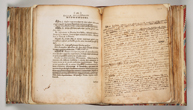Teachers and researchers
 |
Organic Chemistry research laboratory, 1928 (UA CHEM 4.1.7a) |
'Necessary regency', by which MAs and doctors spent two years teaching, collapsed by the late fifteenth century. Although the university established paid lectureships in response, personal instruction was increasingly provided by colleges, a persistent division. Today, university lecturers and college tutors teach an agreed syllabus to one end: degree examinations. In previous centuries, lectures and classes might be unrelated, and teaching vary widely between students focussed on academic distinction and those hoping to scrape a pass or avoid examinations altogether.
Advanced scholarship requires resources; the mental and physical room to think. In Cambridge, intellectual enquiry has been sustained by collegiate community, salaried fellowships and professorships, and material kit. By 1400 the university had a library; by 1800 more than 20 endowed chairs; and from the mid-nineteenth century new laboratories, site of the discoveries - such as splitting the atom or uncovering the structure of DNA - for which it is famous into modern times. Previous reliance on benefaction has broadened into the twenty-first century to encompass income from government, research councils, charities and commerce, alongside many generous individuals.
Click to view larger images:


